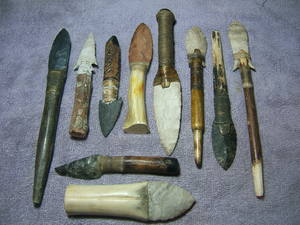While going thru the flea market recently my husband and I came upon a small stand with several lovely Indian Artifacts. As we looked over what was there I thought the prices seemed good and the points were great but instead of spending the rest of the afternoon at that table my husband put his hand on the small of my back in the universal lets move it along gesture. WOW, was I floored. A few booths later a asked what was up. He told me that they were great for reproductions, but as such were a little pricey. Now in all fairness the guy didn’t have them advertised as either authentic or reproduction but the price he was trying for implied authentic. We didn’t stay long enough to inquire because my collector is only in the market for originals right now. This got me to thinking, if I wanted to buy a gift for him or just came upon something that looked like a great deal how would I tell the difference?
I sat and quizzed him later that day and came to realize that it’s tricky business in this day and age to be a collector. I have to admit at this point that he is not only a collector but an accomplished Flintknapper. His work has been sold as period correct reproductions to people who teach archeology and he has given demonstrations to schools, crafts shows and fairs. His work is always signed with a diamond tipped scribe and he runs a signature flake thru the piece to try his best to insure that it never gets sold as original. I can only speak for the Knapper that I live with, but it seems to me that the other people I have met in his limited circle of other knapping enthusiasts all feel the same way about not taking advantage of other collectors. He’s been asked why he even knaps, given that he is a collector himself and knows how devastating it would be to spend a large sum on an arrowhead only to find out it was a fake! To this he answers that he started to knap because he saw it as an art form that he loved, something that grabbed his curiosity and that he felt compelled to learn for his own fulfillment. He also saw that it could have easily died out without the recent resurgence of interest. To this day the only pieces he makes a profit from are the ones that are obviously reproductions, either hanging from a piece of jewelry or set into a table or mounted in such a way that you would never use a valuable artifact. Also, there are very few who ever master the art well enough to fool even the novice collector. Which brings me to the first of several tips to help navigate the world of artifact buying.
It’s one thing to spend $10 or $20 on an artifact taking a stab in the dark at it’s authenticity, but when you are thinking of spending more, not enough to say, send it off to be professionally authenticated, but enough to make it sting if it’s a copy, it wouldn’t hurt to have a reference guide to check and see if that certain type of point that you are contemplating buying was made from that material, in that style and in that time period. This is really the first step in building a good collection. If it’s something you’re collecting then the reading will probably interest you anyway and the more familiar you are with the style of point you are buying the easier it will be to spot things that are not common to that particular style.
First and foremost my in house collector suggested buying, “The Overstreet Indian Arrowheads Identification and Price Guide. We have no stake in the sale of this book. He nor I make a dime by encouraging the sale of this book. He suggests it because he feels it is the best written, clearest guide to not only identifying but also getting an idea of the going rate for all the different styles and types of Arrowhead available. Flipping thru it I found a wealth of information that interested me! The most fascinating part to me was a chronological break down that included things like; 20,000 BP (before present) Cro Magnon man invents the bone needle, followed by the spear thrower, the bone fish hook, the bow and arrow (a millennia later in Europe!), musical instruments of bone and ornaments. The book then gives nearly a thousand pages of points, arranged by region for ease of identification, broken down by era and point type. Laying this ground work for identification will make the more subtle ways of spotting a fake, that I will discuss in the next article, that much easier.





